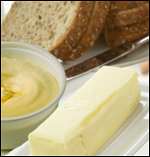Controlling Fat in Your Diet |
 |
 There
are different types of fats and some are healthier than others. It’s
important to limit fat in your diet. One reason to limit total fat intake is
to reduce total calories for weight management. Another reason to limit fat,
especially saturated fat, is to reduce or prevent high blood cholesterol, which is
a major risk factor for heart disease. At this point you may be asking:
There
are different types of fats and some are healthier than others. It’s
important to limit fat in your diet. One reason to limit total fat intake is
to reduce total calories for weight management. Another reason to limit fat,
especially saturated fat, is to reduce or prevent high blood cholesterol, which is
a major risk factor for heart disease. At this point you may be asking:
- How much total dietary fat do I need?
- How do I control my trans fat Intake?
- How do I control my saturated fat intake?
- How do I control my unsaturated fat intake?
For more, see What are the different types of fat and fatty substances?
How much total dietary fat do I need?
The Dietary Guidelines for Americans 2005 recommend that Americans keep their total fat intake within certain limits. This limit is defined as a percentage of your total calorie needs.
| Age Group | Total Fat Limits |
|---|---|
| Children ages 2 to 3 | 30% to 35% of total calories |
| Children and adolescents ages 4 to 18 | 25% to 35% of total calories |
| Adults, ages 19 and older | 20% to 35% of total calories |
You can meet this recommendation by following a healthy meal plan that meets
your calorie needs and is designed to provide 20% to 35% of calories from
total fat.
The USDA Food Guide (My Pyramid.gov) and DASH eating plan are examples of
healthy meal plans that can meet your calorie needs and provide the right
amounts of fat.
- MyPyramid.gov lets you enter your age, sex, height, weight, and activity level to get a meal plan specific to your calorie needs.
-
DASH (Dietary Approaches to Stop Hypertension) Eating Plan
 (PDF-980k) provides a healthy eating plan with menu examples and recipes
to get you started.
(PDF-980k) provides a healthy eating plan with menu examples and recipes
to get you started.
If you have children, you may be concerned about whether they should
watch their fat intake. For proper growth, children and teens need healthy
diets that provide the recommended fat intakes.
Children less than 2 years of age need more calories due to rapid growth and
development. For this reason, nonfat and low-fat milks are not recommended
for children two years and under.1
| Quick Q& A |
|---|
| If some fats are healthier than others, can I eat as much of these fats as I want? |
 No, it's best to keep your total fat intake between 20 and 35% of
your total calories each day. No, it's best to keep your total fat intake between 20 and 35% of
your total calories each day. A healthy eating plan such as MyPyramid (link) or the DASH eating plan (link) contain between 20 and 35% of calories as fat. Check out these plans to get the right amounts of fat you need each day.
|
How do I control my trans fat intake?
|
You may find trans fats in commercial baked goods such as cookies, crackers, and pies. Some commercial restaurants may also use these partially-hydrogenated oils to fry their entrees and side items.
Here are some ideas on how to reduce the trans fat in your diet:
- Look for the Trans fat listing on the Nutrition Facts label. Compare brands and choose the one lowest in trans fat.
- Choose a soft margarine spread instead of stick margarine. Check your labels to be sure the soft margarine does contain less trans fat. If possible, find one that says zero grams of trans fat.
For more, see What are the different types of fat and fatty substances?
|
How do I control my saturated fat intake?
In general, saturated fat can be found in the following foods:
- High-fat cheeses
- High-fat cuts of meat
- Whole-fat milk and cream
- Butter
- Ice cream and ice cream products
So how can you cut back on your intake of saturated fats? Try these tips:
-
Choose leaner cuts of meat that do not have a marbled appearance (where the fat appears embedded in the meat). Leaner cuts include round cuts and sirloin cuts. Trim all visible fat off meats before eating.Marbled meat—– notice the "white" fat throughout the cut. 
In a leaner cut of meat, such as the sirloin shown here, there is less marbling. Most of the fat is on the edges of the meat where you can easily trim it off.

- Remove the skin from chicken, turkey, and other poultry before cooking.
- When re-heating soups or stews, skim the solid fats from the top before heating.
- Drink low-fat (1%) or fat-free (skim) milk rather than whole or 2% milk.
- Buy low-fat or non-fat versions of your favorite cheeses and other milk or dairy products.
- When you want a sweet treat, reach for a low-fat or fat-free version of your favorite ice cream or frozen dessert. These versions usually contain less saturated fat.
- Use low-fat spreads instead of butter. Most margarine spreads contain less saturated fat than butter. Look for a spread that is low in saturated fat and doesn't contain trans fats.
- Choose baked goods, breads, and desserts that are low in saturated fat. You can find this information on the Nutrition Facts label.
- Pay attention at snack time. Some convenience snacks such as sandwich crackers contain saturated fat. Choose instead to have non-fat or low-fat yogurt and a piece of fruit.
To learn more about the Nutrition Facts label, visit How to Understand and Use the Nutrition Facts Label (FDA).
| Quick Q& A |
|---|
| What should I choose— butter or margarine? Should I choose a stick, tub, or liquid? |
 With such a variety of products available, it can be a difficult
decision. Here are some general rules of thumb to help you compare
products: With such a variety of products available, it can be a difficult
decision. Here are some general rules of thumb to help you compare
products:Look at the Nutrition Facts label to compare both the trans fat and the saturated fat content. Choose the one that has the fewest grams of trans fat and the fewest grams of saturated fat and dietary cholesterol. If possible, find one that says zero grams of trans fat. When looking at the Daily Value for saturated fat and cholesterol remember that 5 percent is low and 20 percent is high. If you are also trying to reduce calories, you may want to look for a version that says "light." These products contain fewer calories and can help you stay within your calorie goals. If you find two products that seem comparable, try them both and choose the one that tastes better!
|
How do I control my polyunsaturated fat and monounsaturated fat intake? |
 |
In general, nuts, vegetable oils, and fish are sources of unsaturated fats. The table below provides examples of specific types of unsaturated fats.
| Monounsaturated Fat Sources | Omega-6 Polyunsaturated Fat Sources | Omega-3 Polyunsaturated Fat Sources |
|---|---|---|
|
Nuts Vegetable oils Canola oil Olive oil High oleic safflower oil Sunflower oil Avocado |
Soybean oil Corn oil Safflower oil |
Soybean oil Canola oil Walnuts Flaxseed Fish: trout, herring, and salmon |
Below are tips for including appropriate amounts of unsaturated fats in your
diet:
- Replace solid fats used in cooking with liquid oils. Visit MyPyramid.gov "What's My Allowance?" to learn more about your daily recommendations.
- Remember any type of fat is high in calories. To avoid additional calories, substitute polyunsaturated and monounsaturated fats for saturated fats and trans fats rather than adding these fats to your diet.
- Have an ounce of dry-roasted nuts as a snack. Nuts and seeds count as part of your meat and beans allowance on the MyPyramid plan.
For more, see What are the different types of fat and fatty substances?
Related Information
Dietary Guidelines Health Facts: Know Your Fats ![]() (PDF-88k)
(PDF-88k)
Know Your Fats explains what you need to know about fats. Fats and oils are
part of a healthy diet and play many important roles in the body but can
impact the health of your heart and arteries in a positive or negative way,
depending on the types of fat you eat.
Sources
1Source: American Academy of Pediatrics (AAP), Pediatric Nutrition Handbook (5th edition), 2003, pg. 126.
![]() Please note: Some of these publications are available for download only as *.pdf files. These files require Adobe Acrobat Reader in order to be viewed. Please review the information on downloading and using Acrobat Reader software.
Please note: Some of these publications are available for download only as *.pdf files. These files require Adobe Acrobat Reader in order to be viewed. Please review the information on downloading and using Acrobat Reader software.
* Links to non-Federal organizations found at this site are provided solely as a service to our users. These links do not constitute an endorsement of these organizations or their programs by CDC or the Federal Government, and none should be inferred. CDC is not responsible for the content of the individual organization Web pages found at these links.
Page last updated: March 6, 2008
Content Source: Division of Nutrition, Physical Activity and Obesity, National Center for Chronic Disease Prevention and Health Promotion


